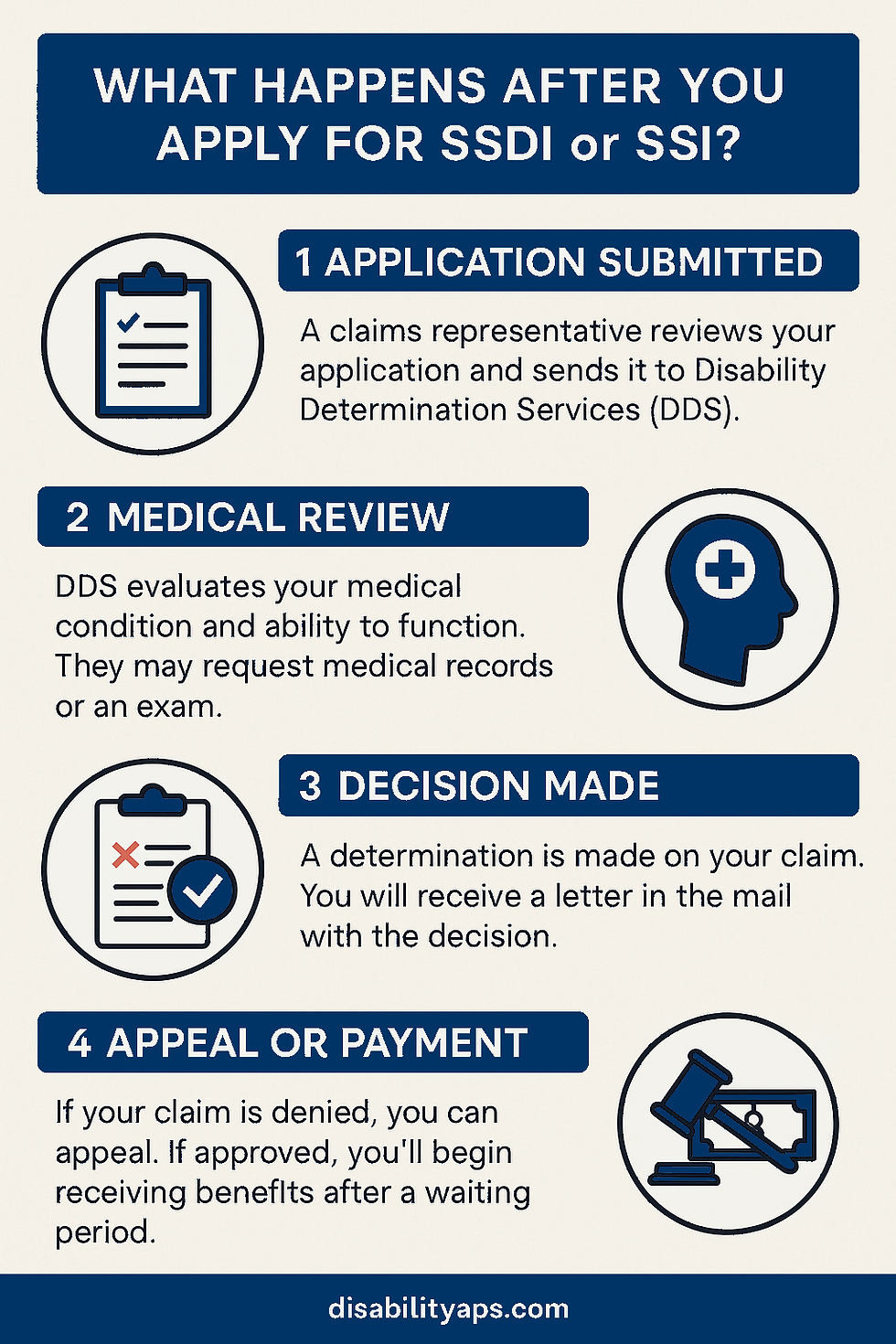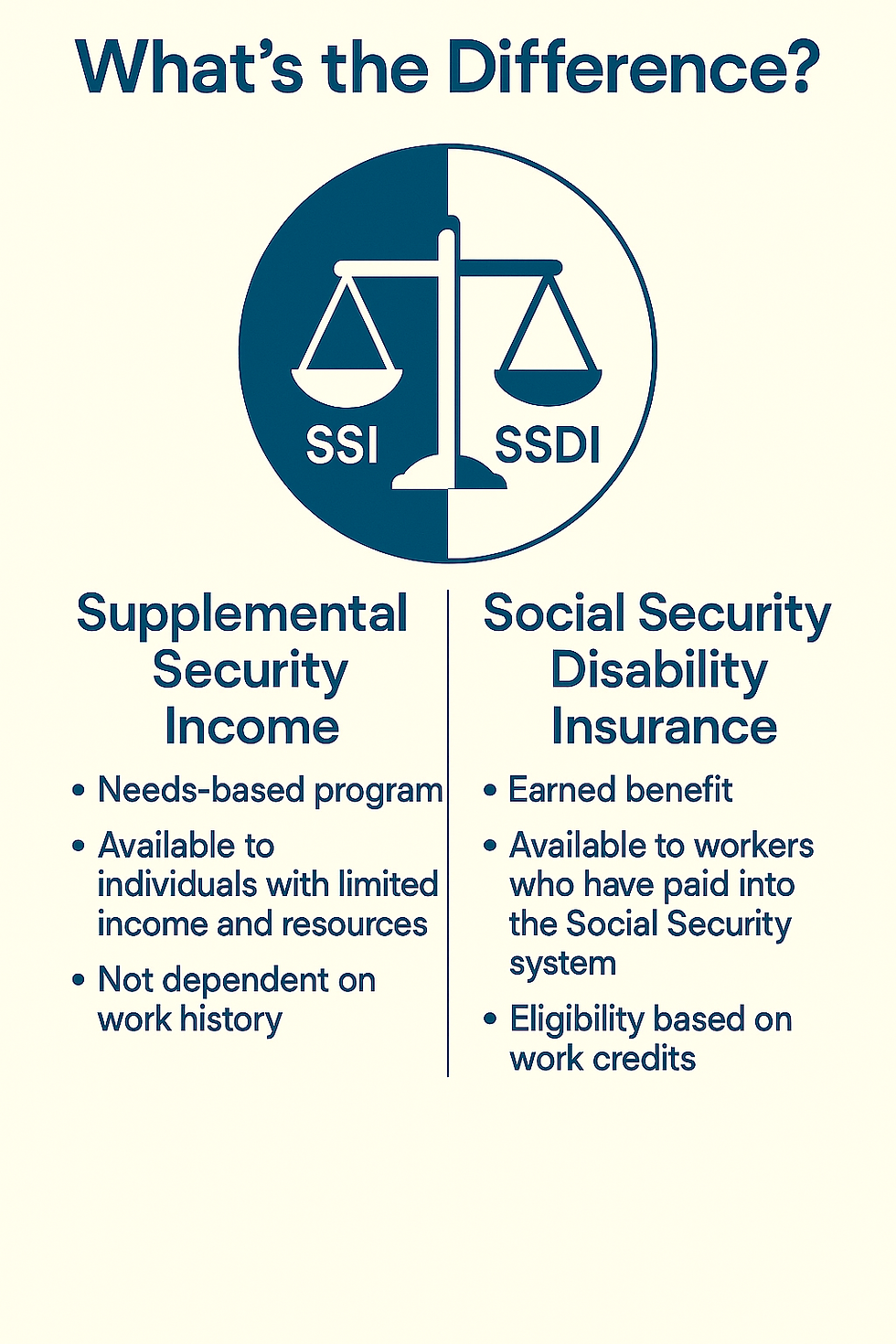Top 5 Mistakes People Make When Filing for Social Security Disability Benefits
- Advocate Pathway Solutions

- Sep 22
- 6 min read

Applying for Social Security Disability benefits is a marathon, not a sprint. Between understanding eligibility, gathering medical evidence, and tracking deadlines, it’s easy to make small mistakes that cause big delays—or denials. The good news: most early errors are fixable with the right plan. Below, I’ll walk you through the five most common mistakes people make when filing for Social Security Disability Insurance (SSDI) or Supplemental Security Income (SSI), why they matter, and exactly how to avoid them.
At the end, you’ll find a practical checklist you can use today to tighten up your claim before you click “submit.”
1. Mistake #1: Submitting Incomplete (or Unfocused) Medical Records
Why it hurts your case:
SSA must see clear, objective proof of a medically determinable impairment from acceptable medical sources. If your records are thin, outdated, or scattered across multiple providers with gaps in care, it’s harder for the agency to connect the dots between your diagnosis and your functional limitations at work and in daily life. SSA’s rules emphasize objective medical evidence from acceptable medical sources to establish an impairment.
What “complete” looks like:
Diagnostic evidence: imaging, labs, clinical tests, and specialist notes that show the existence and severity of your condition.
Longitudinal treatment history: records that tell a consistent story over time (not just one urgent care visit).
Functional detail: notes that translate symptoms into concrete limitations (sitting/standing tolerances, lifting limits, postural restrictions, cognitive stamina, need for breaks, absenteeism).
Provider opinions: medical source statements that explain how your impairments affect work-related activities (e.g., pace, persistence, attendance).
Common pitfalls:
Relying on self-reports without supporting tests or examinations.
Gaps in care that raise questions about severity.
Assuming SSA will collect every record automatically (you have a duty to submit or inform SSA about all evidence you know of that relates to your disability).
How to fix it (now):
Map your care for the last 12–24 months: primary care, specialists, ER/urgent care, therapy, imaging centers, and labs. Request records from each.
Prioritize “objective + functional”: highlight records that quantify limitations (e.g., “can stand 10 minutes,” “misses 3+ days/month”).
Detailed statement: get a detailed statement from your treating provider addressing why you cannot sustain full-time work.
Keep it current: submit updated records if your condition changes or you have new testing.
2. Mistake #2: Missing Deadlines (Appeals, Evidence, and Everything In Between)
Why it hurts your case:
SSA runs on strict timelines. If you miss them, you can lose appeal rights and face dismissal. Generally, you have 60 days from when you receive a decision notice to appeal (SSA presumes you receive it five days after the date on the notice). If you request Appeals Council review after a hearing, that’s also 60 days.
There’s more than one deadline:
Reconsideration after an initial denial: 60 days from receipt.
Hearing evidence rule: you generally must submit or notify the judge about new evidence no later than five business days before the hearing date.
Good cause: If you file late, SSA can excuse it in limited circumstances (e.g., misinformation from SSA, not receiving the notice), but you must explain and document why.
How to avoid deadline disasters:
Create a master timeline (initial decision → reconsideration → hearing → Appeals Council). Put every due date on a calendar with multiple reminders.
Keep proof: mail with tracking, save fax receipts or online confirmations.
Front-load evidence: don’t wait until the week of the hearing to chase records.
If you’re late: file immediately with a written “good cause” explanation and supporting documents. A missed appeal can be dismissed if good cause isn’t shown.
3. Mistake #3: Continuing to Work Above the SGA Level - Resulting in a Denial of Social Security Disability Benefits
Why it hurts your case:
SSA looks at whether you can perform substantial gainful activity (SGA). If you’re earning above SGA when you apply, SSA may issue a technical denial before even evaluating your medical evidence.
Know the 2025 SGA numbers:
$1,620/month for non-blind claimants.
$2,700/month for statutorily blind claimants.
Important nuance:
Below SGA earnings do not guarantee approval, but they avoid a technical denial so SSA can actually review your medical case.
Averages matter: SSA often looks at average monthly earnings; a single high paycheck can complicate things.
Special situations exist (e.g., “sheltered” work, extensive subsidies, or unsuccessful work attempts), but these are nuanced—get guidance if this applies to you.
How to avoid the SGA trap:
Check your gross earnings (before taxes) against the SGA limit.
If you must work, keep hours consistent with your limitations and maintain thorough documentation (breaks, missed days, accommodations).
Keep pay stubs and a simple earnings log to show month-by-month totals.
4. Mistake #4: Not Following Prescribed Treatment (Without a Good Reason)
Why it hurts your case:
Regulations require you to follow treatment prescribed by your medical source(s) if it’s expected to restore your ability to work. If you don’t—without a good reason—SSA may find you not disabled or stop benefits. SSA’s SSR 18-3p explains how adjudicators evaluate whether someone failed to follow prescribed treatment, including the evidence they consider.
What this looks like in real life:
Not taking prescribed medications (without reporting side effects or contraindications).
Skipping recommended therapy, specialist referrals, or CPAP use for sleep apnea.
Refusing surgery that carries low risk and high likelihood of restoring function (case-by-case).
Good reasons may exist:
SSA considers context. For example, conflicting medical advice, high-risk procedures, or other documented, justifiable reasons can be relevant. (Bottom line: communicate with your provider, document issues like adverse side effects, and get alternatives in writing.)
How to avoid this mistake:
Follow the plan and keep records showing you’re doing so.
Report problems early (side effects, access issues) and ask your provider to document them.
Ask for alternatives if a treatment isn’t tolerable or safe for you and get that medical rationale in your chart.
Track adherence (medication refills, therapy attendance) so you can show consistency.
5. Mistake #5: Filing Alone Without Guidance (and Getting Lost in the Process)
Why it hurts your case:
The disability process is technical. Forms must align with medical evidence; records must show not just a diagnosis but functional limitations over time; deadlines and evidence rules are strict; and SSA uses a multi-step sequential evaluation that can be hard to track. Many denials happen because applications are incomplete, unfocused, or miss key proof of how your condition prevents full-time work.
How representation helps:
Evidence strategy: pinpoint which tests, notes, and functional observations matter most (and request them early).
Story coherence: ensure your work history, daily activities, and medical records all tell the same story.
Deadline control: set up a system so nothing slips.
Hearing prep: sharpen testimony to focus on the limitations SSA evaluates (e.g., pace, persistence, absenteeism).
SSA does not require you to have a representative. But having one can reduce avoidable errors and speed up evidence development so your strongest case gets in front of the decision-maker. It would be wise to at least get a professional case evaluation before filing. You can start a free review with our team at disabilityaps.com/claim-evaluation.
6. Building a Winning Application
Winning a disability case isn’t about flooding SSA with paper—it’s about presenting the right evidence, on time, with a clear functional story. Avoiding the five mistakes above will keep your claim moving and give adjudicators what they need to make a fair decision:
Build a complete, objective, functional medical record.
Never miss a deadline—appeal clocks are strict.
Keep earnings below SGA while your claim is pending.
Follow treatment or document good reasons if you can’t.
Get help so your evidence, forms, and timeline all align.
If you want hands-on support, a representative can organize records, manage deadlines, and prepare you for what SSA will ask—so you can focus on your health while your case is built the right way from day one.
Representation fees are capped at the lesser of 25 percent of past-due benefits or $9,200 (2025 limit) and are paid directly by SSA out of your back pay. There is usually no upfront cost.
Ready to move forward? Visit disabilityaps.com/claim-evaluation and upload your information. We’ll clarify your eligibility, identify missing records, and chart the fastest path to approval.
Qualifying for Social Security Disability benefits isn’t about luck—it’s about meeting clearly defined rules and proving it with solid evidence. By understanding how SSA evaluates work history, financial need, and medical severity, you can decide whether to apply, avoid common mistakes, and present the strongest possible case. Whether you file on your own or enlist professional help, a proactive, organized approach can turn an overwhelming process into a manageable one—and bring you closer to the financial security you deserve.




Comments